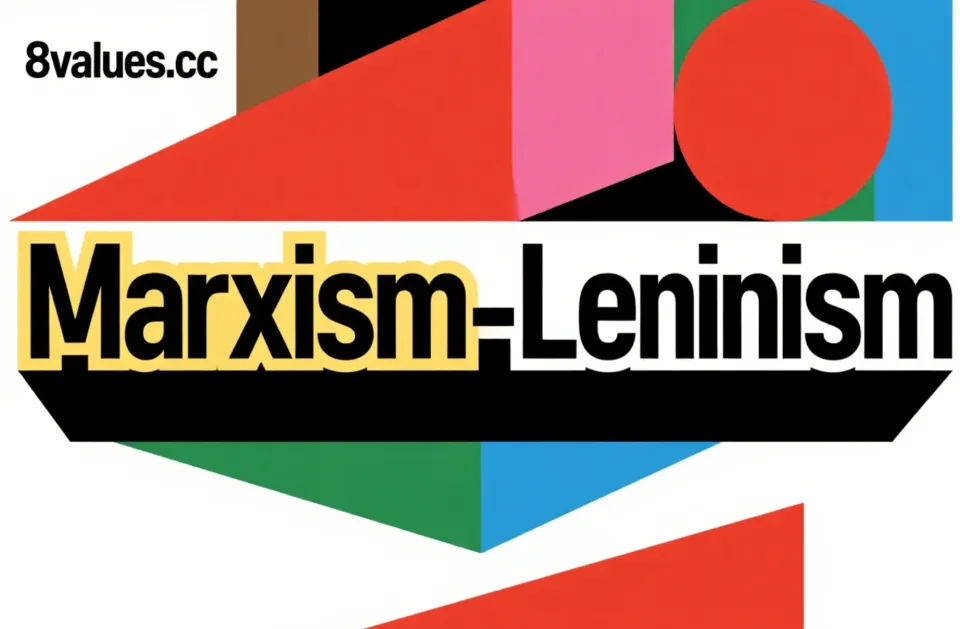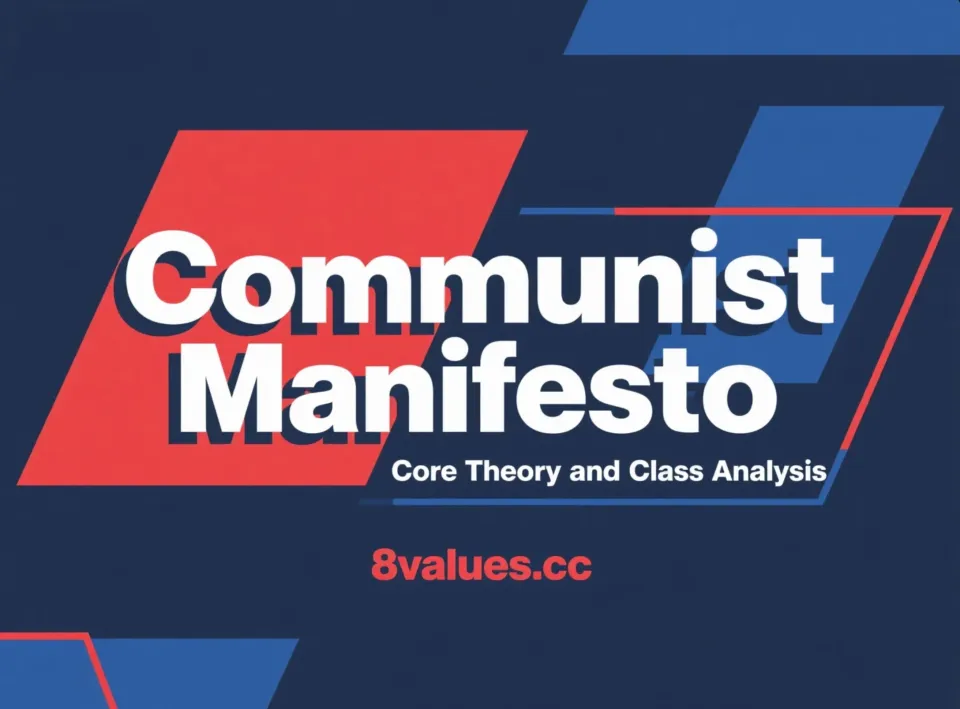ตลาดอนาธิปไตย 8 ค่าตีความอุดมการณ์อุดมการณ์ของการทดสอบทางการเมือง
สำรวจตลาดอนาธิปไตยในผลลัพธ์ของการทดสอบทางการเมือง 8 ค่านิยมแนวคิดทางการเมืองที่สนับสนุนสังคมไร้สัญชาติและบรรลุความสงบเรียบร้อยทางสังคมผ่านตลาดเสรี บทความนี้จะวิเคราะห์ข้อเสนอหลักโรงเรียนหลักเส้นทางการปฏิบัติและความท้าทายและการวิพากษ์วิจารณ์ในรายละเอียดช่วยให้คุณเข้าใจทฤษฎีเศรษฐศาสตร์นี้อย่างเต็มที่ที่เน้นเสรีภาพส่วนบุคคลและการซื้อขายโดยสมัครใจ ไม่ว่าคำถามของคุณเกี่ยวกับการกระจายอำนาจทรัพย์สินส่วนตัวหรือความเสมอภาคทางสังคมคุณจะพบการตีความเชิงลึกที่นี่
ใน สเปกตรัมทางการเมืองที่ซับซ้อนของ 8 ค่านิยม การตลาดอนาธิปไตย ให้มุมมองที่น่าสนใจตั้งครรภ์รูปแบบทางสังคมที่รักษา ความสงบเรียบร้อยทางสังคม โดยไม่ต้องมีการแทรกแซงจากรัฐบาลและ ตลาดเสรี และ การมีปฏิสัมพันธ์ทางเศรษฐกิจโดยสมัครใจ หากคุณได้รับผลของ "การตลาดผิดปกติ" ใน การทดสอบทางการเมือง 8 ค่า ที่ดำเนินการโดย เว็บไซต์ 8 ค่าคำถาม คุณอาจอยากรู้อยากเห็นเกี่ยวกับ ปรัชญาการเมือง นี้ที่เน้น เสรีภาพส่วนบุคคล และ การตัดสินใจด้วยตนเอง บทความนี้จะขึ้นอยู่กับข้อมูลแบบบูรณาการอย่างละเอียดเพื่อให้คุณวิเคราะห์เชิงลึกเกี่ยวกับทุกสิ่งเกี่ยวกับ อนาธิปไตยในตลาด ช่วยให้คุณเข้าใจ อุดมการณ์ ที่เป็นเอกลักษณ์นี้ได้ดีขึ้นการวางตำแหน่งใน พิกัดของสเปกตรัมทางการเมือง และความแตกต่างจาก อุดมการณ์ อื่น ๆ
แนวคิดหลักของการอนาธิปไตยในตลาด: ไม่มีประเทศตลาดเสรีและความเป็นอิสระของแต่ละบุคคล
ตลาดอนาธิปไตย หรือที่เรียกว่า " อนาธิปไตยตลาดเสรี " เป็นปรัชญาการเมืองอนาธิปไตยและทฤษฎีเศรษฐศาสตร์ ข้อเสนอหลักของมันคือในกรณีที่ไม่มีรัฐ (รัฐบาล) สังคมสามารถจัดระเบียบและดำเนินการโดยอัตโนมัติผ่าน กลไกการตลาดของการแข่งขันฟรี
หลักการพื้นฐานของการรักษาอนาธิปไตยในตลาด ได้แก่ :
- การยกเลิกการแทรกแซงของรัฐและการผูกขาด : นักทำตลาดในตลาด เชื่อว่ารัฐเป็นการผูกขาดอำนาจบีบบังคับ พวกเขาสนับสนุนการปฏิเสธอย่างสมบูรณ์เกี่ยวกับความชอบธรรมของรัฐบาลโดยเชื่อว่ารัฐบาลเป็นรากฐานของความรุนแรงและการแสวงประโยชน์และภาษีการกำกับดูแลและการผูกขาดควรถูกยกเลิก พวกเขาเชื่อว่าการผูกขาดที่มีอยู่ไม่ใช่ผลิตภัณฑ์ธรรมชาติของ ตลาดเสรี แต่เป็นผลมาจาก การแทรกแซงของรัฐ
- ตลาดแทนที่หน้าที่ของรัฐ : โอนหน้าที่ผูกขาดของรัฐเช่น ความมั่นคงสาธารณะความยุติธรรมการป้องกันประเทศ และ การบริการสาธารณะ ไปยัง ตลาดที่มีการแข่งขันอย่างอิสระ และจัดทำโดยองค์กรเอกชนสหกรณ์หรือองค์กรชุมชน
- ตัวเลือกฟรีและการแข่งขันในตลาด : ผู้คน มีอิสระที่จะเลือกซื้อ บริการที่ต้องการ พวกเขาเชื่อว่า การแข่งขันในตลาด นี้ช่วยให้ผลิตภัณฑ์และบริการ ที่มีคุณภาพสูงกว่า และสามารถส่งเสริม ประสิทธิภาพและนวัตกรรม
- ความร่วมมือและการทำธุรกรรมโดยสมัครใจ : ปฏิสัมพันธ์ทางสังคมและเศรษฐกิจทั้งหมดควรขึ้นอยู่กับ ความยินยอมโดยสมัครใจ โดยไม่ต้องมีรัฐบาลบังคับหรือการแทรกแซงสถาบัน การตลาดของแอนูซีนิยม อาศัย การมีปฏิสัมพันธ์ทางเศรษฐกิจโดยสมัครใจ เพื่อสร้าง ระเบียบทางสังคม
- เสรีภาพส่วนบุคคลและการเป็นเจ้าของตนเอง : เน้นว่าบุคคลมีอิสระอย่างเต็มที่ในขณะที่รับผิดชอบอย่างเต็มที่ต่อการกระทำและตัวเลือกของตนเอง นี่คือรูปแบบของ ลัทธิอนาธิปไตยแบบปัจเจกนิยม
- การกระจายอำนาจและความหลากหลายทางการเมือง : ต่อต้านโครงสร้างอำนาจส่วนกลางและสนับสนุนการกระจายอำนาจไปยังบุคคลและชุมชนขนาดเล็ก พวกเขาสนับสนุนผู้คนที่ให้อำนาจทุกชุมชนมีอิทธิพลอย่างมีความหมายและกำหนดชีวิตของพวกเขาแม้ว่าพวกเขาจะไม่ชอบใช้ระบบการตลาด
- สิทธิ์ในทรัพย์สิน : โดยปกติจะสนับสนุน ทรัพย์สินส่วนตัว และการทำธุรกรรมฟรีของอสังหาริมทรัพย์เชื่อว่าเป็นพื้นฐานสำหรับการดำเนินงานในตลาด อย่างไรก็ตามมีความแตกต่างเกี่ยวกับรูปแบบเฉพาะของ ทรัพย์สินส่วนตัว โดยเฉพาะอย่างยิ่งหลักการของ "การครอบครองและการใช้งาน"
โรงเรียนหลักของตลาดอนาธิปไตย: จุดตัดและการพัฒนาความคิดหลายอย่าง
การตลาด anacticism ไม่ใช่แนวคิดเดียวมีโรงเรียนหลายแห่งอยู่ในนั้นแต่ละแห่งมุ่งเน้นไปที่แนวคิดของ ตลาดเสรี และ สังคมอนาธิปไตย
การรวมกัน
Adual Aidism เป็นหนึ่งในแนวโน้มที่เร็วที่สุดและได้รับการพัฒนามากที่สุดของ การอนาธิปไตยในตลาด อย่างละเอียดโดยนักคิดชาวฝรั่งเศส Pierre-Joseph Proudhon มันรวมแนวคิดของเศรษฐกิจตลาดและสหกรณ์เน้น การแลกเปลี่ยนซึ่งกันและกันและการแลกเปลี่ยนที่เป็นธรรม และสนับสนุน การมีปฏิสัมพันธ์ทางเศรษฐกิจที่ไม่เป็นประโยชน์
- ข้อเสนอหลัก : คนงานควรควบคุมวิธีการผลิตและสร้าง ตลาดเสรี ที่ประกอบด้วยช่างฝีมือและสหกรณ์คนงาน มันเป็นไปตาม ทฤษฎีมูลค่าแรงงาน เชื่อว่ามูลค่าของผลิตภัณฑ์ถูกกำหนดโดยแรงงานต่อต้าน "รายได้ฟรี" เช่นดอกเบี้ยกำไรและค่าเช่าและถือว่าเป็นการเอารัดเอาเปรียบ
- สิทธิในทรัพย์สิน : หลักการของ "อาชีพโดยเร็วที่สุด" คือบุคคลนั้นสามารถควบคุมผลิตภัณฑ์ที่ได้มาหรือใช้ผ่านแรงงานได้อย่างเต็มที่ แต่การเป็นเจ้าของที่ดินควรถูก จำกัด เวลาที่ใช้อย่างต่อเนื่อง สิ่งนี้มีวัตถุประสงค์เพื่อป้องกันไม่ให้บุคคลได้รับค่าเช่าหรือใช้ประโยชน์จากผู้อื่นโดยการกักตุนที่ดินที่ไม่ได้ใช้หรือวิธีการผลิต
- ตัวแทน : Pierre-Joseph Proudhon และผู้นิยมอนาธิปไตยอเมริกันเบนจามินทัคเกอร์
อนาธิปไตย-ทุนนิยม
ทุนนิยมแบบอนาธิปไตย ตรงกันข้ามกับ การช่วยร่วมกัน ซึ่งสนับสนุน ทรัพย์สินส่วนตัว และ กลไกการตลาด อย่างแน่นอนเป็นวิธีเดียวในการจัดระเบียบสังคม
- ข้อเสนอหลัก : เน้นเศรษฐกิจตลาดเสรีอย่างสมบูรณ์และ ความเป็นเจ้าของส่วนตัว และสนับสนุนให้บริการทั้งหมด (รวมถึงกฎหมายและการป้องกัน) สามารถให้ผ่านการแข่งขันในตลาด มันยอมรับ ทฤษฎีอัตนัย ของคุณค่าช่วยให้การสร้างผลกำไรและผลประโยชน์
- สิทธิในทรัพย์สิน : นายทุนอนาธิปไตยผู้นิยมอนาธิปไตย Rothbardian เชื่อว่า ทรัพย์สินส่วนตัว สามารถสร้างขึ้นได้จากผลิตภัณฑ์ของแรงงานและสามารถแปลงผ่านขั้นตอนการค้าของขวัญหรือการละทิ้งและถือได้ว่าเป็น "สิทธิมนุษยชน"
- ผู้แทน : นักเศรษฐศาสตร์ Murray Rothbard, David Friedman และนักเศรษฐศาสตร์ชาวฝรั่งเศสในศตวรรษที่ 19 Gustave de Molinari
- ประเด็นที่ถกเถียงกัน : ผู้ช่วยร่วมกันวิพากษ์วิจารณ์ทุนนิยมอนาธิปไตยเชื่อว่าการเรียกร้องของพวกเขาจะนำไปสู่ตลาดที่ถูกครอบงำโดย บริษัท ไม่กี่แห่งซึ่งก่อให้เกิด การผูกขาดส่วนตัว ใหม่และ ความมั่งคั่ง
อนาธิปไตยตลาดซ้าย
ตลาดฝ่ายซ้าย Anaccarism พยายามรวมกลไกการตลาดเข้ากับแนวโน้ม ต่อต้านทุนนิยม โดยมีเป้าหมายเพื่อให้บรรลุ ความเท่าเทียมกัน และ การกระจายอำนาจ ทางสังคมผ่านตลาด
- ข้อเสนอหลัก : วิพากษ์วิจารณ์ ความเป็นเจ้าของส่วนตัวของนายทุน เชื่อว่าต้องอาศัยความรุนแรงของรัฐในการรักษาและสนับสนุนการตระหนักถึงสิทธิในทรัพย์สินผ่านความช่วยเหลือซึ่งกันและกันและความร่วมมือหรือหลักการของ "อาชีพและการใช้" มันเน้นว่าตลาดเป็น " เครื่องมือกระจายอำนาจ " มากกว่าข้าราชบริพารของ ทุนนิยม และมุ่งเน้นไปที่ ความเท่าเทียม และ การต่อต้านการสำรวจ
- ตัวแทน : เบนจามินทัคเกอร์และนักวิชาการบางคนตีความทฤษฎีของ Deleuze และ Guattari ในฐานะ อนาธิปไตยตลาดซ้าย โดยเน้นการเร่งการเปลี่ยนแปลงทางสังคมผ่านตลาด
- C4SS : ศูนย์เพื่อสังคมไร้สัญชาติ (C4SS) เป็นผู้นิยมอนาธิปไตยคิดว่ารถถังและศูนย์สื่อที่อุทิศให้กับการตีความและการป้องกันความคิด ของผู้นิยมอนาธิปไตยในตลาด มันทำหน้าที่เป็นบ้านสถาบันของ ผู้นิยมอนาธิปไตยตลาดซ้าย
ความเป็นอยู่
Agoraism ได้รับการเสนอโดยซามูเอลเอ็ดเวิร์ด Konkin III และเป็นปรัชญาสังคม เสรีนิยม ที่ตระหนักถึงการเปลี่ยนแปลงทางสังคมผ่าน " การต่อต้าน-เศรษฐกิจ "
- ข้อเสนอหลัก : การต่อต้านเศรษฐกิจ หมายถึง พฤติกรรมของมนุษย์ที่ไม่ก้าวร้าว ทั้งหมดซึ่งถูกห้ามควบคุมควบคุมภาษีหรือกำหนดโดยรัฐรวมถึงตลาดเสรีตลาดมืดเศรษฐกิจใต้ดิน ฯลฯ Agoraists เชื่อว่าผ่าน "การไม่เชื่อฟังพลเรือนที่ทำกำไรได้"
- กรณีปฏิบัติ : เช่นชุมชนที่สร้างขึ้นรอบ ๆ เครือข่ายผู้ผลิตและความร่วมมือของผู้บริโภคธุรกิจขนาดเล็กหน่วยงานช่วยเหลือซึ่งกันและกันกลุ่ม DIY สวนชุมชนและสหภาพเครดิต
กลไกการดำเนินงานของตลาด anaccarism: แนวคิดของฟังก์ชั่นของรัฐทางเลือก
ใน สังคมอนาธิปไตย ที่เกิดจากผู้นิยม อนาธิปไตยในตลาด การบริการสาธารณะต่าง ๆ ที่จัดทำโดยรัฐจะถูกแทนที่ด้วยกลไก ตลาดเสรี
- การเมืองและความยุติธรรม : บุคคลและธุรกิจจะซื้อบริการจาก หน่วยงานป้องกันเอกชน และ ตำรวจเอกชน เพื่อปกป้องตนเอง ข้อพิพาทจะได้รับการแก้ไขผ่าน อนุญาโตตุลาการโดยสมัครใจ และรางวัลอนุญาโตตุลาการได้รับการบังคับใช้โดยหน่วยงานเอกชน พวกเขาเชื่อว่า การแข่งขันในตลาด จะกระตุ้นให้ผู้ให้บริการเหล่านี้ให้บริการ ที่ถูกกว่าและมีคุณภาพสูงกว่า
- โครงสร้างพื้นฐาน : ถนนไฟฟ้าการสื่อสารและโครงสร้างพื้นฐานอื่น ๆ จะ ถูกสร้างดำเนินการและดูแลโดย บริษัท เอกชน และผู้ใช้จะถูกเรียกเก็บตามหลักการของตลาด Market Anacists เชื่อว่าการขนส่ง ที่วางแผนไว้จากส่วนกลาง หรือโครงการอื่น ๆ นั้นไม่มีประสิทธิภาพเพราะมีสิ่งที่ Hayek เรียกว่า " ปัญหาความรู้ "
- สกุลเงินและการธนาคาร : ผู้สนับสนุนเพื่อให้บุคคลดำเนินธุรกิจธนาคารด้วยตนเองและออก สกุลเงินส่วนตัว ของตนเพื่อยุติการผูกขาดเครดิตของรัฐบาล เบนจามินทัคเกอร์เชื่อว่าสิ่งนี้จะก่อให้เกิดการแข่งขันที่รุนแรงในภาคการธนาคารซึ่งจะช่วยลดอัตราดอกเบี้ยกระตุ้นผู้ประกอบการและเพิ่มค่าจ้างสำหรับคนงานในที่สุด
- เครือข่ายประกันสังคม : การตลาดของ Anaciism เชื่อว่านโยบายของรัฐบาลเพิ่มค่าใช้จ่ายการอยู่รอดขั้นพื้นฐานของคนที่ยากจนที่สุด ในตลาดที่ไม่มีการบังคับใช้รัฐ เกี่ยวกับความขาดแคลน และ สิทธิพิเศษ ของรัฐชนชั้นแรงงานจะมีทรัพยากรมากขึ้นในการลงทุนใน ระบบความช่วยเหลือร่วมกัน/ความร่วมมือ อวนความปลอดภัยที่จัดด้วยตนเอง เช่นสมาคมช่วยเหลือซึ่งกันและกันและสมาคมที่เป็นมิตรสามารถตอบสนองความต้องการจำนวนมาก
ความแตกต่างระหว่างอนาธิปไตยตลาดและความคิดทางการเมืองอื่น ๆ : การทำความเข้าใจเอกลักษณ์ของมัน
ตลาด anaccarism ครอบครองตำแหน่งที่ไม่ซ้ำกันใน 8 ค่าทางการเมืองสเปกตรัม ซึ่งมีทั้งรากใน เสรีนิยมคลาสสิก และการตัดกันกับประเพณี สังคมนิยม ในขณะเดียวกันก็ต่อต้านการเรียกร้องบางอย่างของ ลัทธิคอมมิวนิสต์ อย่างชัดเจน
การเปรียบเทียบระหว่างตลาด anaccarism และสังคมนิยม :
- ความแตกต่าง : โดยทั่วไป สังคมนิยม เชื่อว่า การกำกับดูแลของตลาด เป็นกุญแจสำคัญในการป้องกันการแสวงประโยชน์และสร้างความมั่นใจ ในความเท่าเทียมกันทางสังคม และมีแนวโน้มที่จะ มุ่งเน้นไปที่ระบบเศรษฐกิจ ตลาด anacticism เชื่อว่า การแทรกแซงของรัฐ เป็นรากฐานของการแสวงหาผลประโยชน์และท้าทายความเชื่อของ สังคมนิยม ว่าการแทรกแซงของรัฐเป็นสิ่งจำเป็นเพื่อปกป้องคนงานและให้แน่ใจว่าการกระจายทรัพยากรอย่างเท่าเทียมกัน
- คะแนนทั่วไป : ผู้นิยมอนาธิปไตยในตลาด หลายคนเชื่อว่าในที่สุด ตลาดเสรี จะนำไปสู่สังคมที่คนงานมีวิธีการผลิตซึ่งสอดคล้องกับเป้าหมาย สังคมนิยม นักวิชาการในตลาด บางคนก็เห็นด้วยกับฉลากของ การต่อต้านทุนนิยม หรือ ลัทธิสังคมนิยมเสรีนิยม
การเปรียบเทียบระหว่างตลาด anaccarism และคอมมิวนิสต์ :
- ความแตกต่าง : คอมมิวนิสต์ มีจุดมุ่งหมายเพื่อยกเลิก ทรัพย์สินและตลาดส่วนตัว อย่างสมบูรณ์ การตลาดของ Anaciism สนับสนุน กลไกการตลาด และ สิทธิ์ในทรัพย์สินส่วนบุคคล ลัทธิอนาธิปไตยคอมมิวนิสต์ ต่อต้าน ความเป็นเจ้าของส่วนตัว และ เศรษฐกิจการตลาด และสนับสนุน การเป็นเจ้าของโดยรวม และ สังคมที่ไม่มีชนชั้น
การเปรียบเทียบระหว่างตลาด anaccarism และลัทธิเสรีนิยมแบบคลาสสิก :
- จุดร่วม : ตลาด anaccharism มีต้นกำเนิดในระดับหนึ่งจาก ลัทธิเสรีนิยมแบบคลาสสิก โดยเฉพาะอย่างยิ่งการเน้นไปที่ ตลาดเสรี และ สิทธิส่วนบุคคล มันผลักดัน ทฤษฎีกฎหมายธรรมชาติ (ชีวิตเสรีภาพสิทธิในทรัพย์สิน) ไปสู่ความรุนแรง
- ความแตกต่าง : การตลาด anacticism เชื่อว่ารัฐละเมิด เสรีภาพส่วนบุคคล และ สิทธิในทรัพย์สิน ผ่านบริการผูกขาดและการเก็บภาษีในขณะที่ ลัทธิเสรีนิยมแบบคลาสสิก โดยทั่วไปเชื่อว่ารัฐเป็นผู้ปกป้องสิทธิเหล่านี้
การเปรียบเทียบของอนาธิปไตยในตลาดและอนาธิปไตยแบบดั้งเดิม :
- คะแนนทั่วไป : เช่นเดียวกับความคิดอนาธิปไตยทั้งหมด ตลาดอนาธิปไตย ต่อต้านระบบชั้นเรียนภาคบังคับและการมีอยู่ของรัฐ
- ความแตกต่าง : การตลาด anacticism มุ่งเน้นไปที่การใช้ หลักการของตลาดเสรี เพื่อจัดระเบียบสังคมแทนที่จะมุ่งเน้นไปที่ สหกรณ์ หรือ ประชาธิปไตยโดยตรง เช่นสาขาอนาธิปไตยอื่น ๆ อนาธิปไตยแบบดั้งเดิมอาจเน้น ความร่วมมือของชุมชน และ ต่อต้านทุนนิยม มากขึ้น
ความท้าทายและการวิพากษ์
แม้ว่าแนวคิดทางทฤษฎีของ การทำอนาธิปไตยในตลาด นั้นสะดุดตา แต่ก็ต้องเผชิญกับ ความท้าทายและการวิพากษ์วิจารณ์ จากค่ายอุดมการณ์ที่แตกต่างกันในระดับและตรรกะในทางปฏิบัติ
คำถามความเป็นไปได้ :
- ปัญหาสินค้าสาธารณะ : นักวิจารณ์ตั้งคำถามว่าจะจัดหา สินค้าสาธารณะ ได้อย่างมีประสิทธิภาพ (เช่นการคุ้มครองสิ่งแวดล้อมวิทยาศาสตร์พื้นฐานโครงสร้างพื้นฐานขนาดใหญ่) หรือแก้ปัญหาการประสานงานขนาดใหญ่โดยไม่มีรัฐบาล
- ความล้มเหลวของตลาด : มุมมองของ ตลาดเสรียูโทเปีย มักถูกวิพากษ์วิจารณ์ว่าเป็นการละเลย ความล้มเหลวของตลาด และปัญหาของ ความเข้มข้นของพลังงาน
- ประสบการณ์ทางประวัติศาสตร์ : สังคมไอซ์แลนด์ยุคกลางมักถูกอ้างถึงเป็นตัวอย่างของ "สังคมไร้สัญชาติ" แต่ในที่สุดก็นำไปสู่สงครามกลางเมืองเพราะ ความมั่งคั่งและอำนาจถูกรวมอยู่ ในมือของครอบครัวไม่กี่ครอบครัวและถูกใช้โดยกษัตริย์นอร์เวย์และในที่สุดก็ฟื้นฟูระบบของรัฐ
ภาวะที่กลืนไม่เข้าคายไม่ออกทางสังคม :
- ความเข้มข้นของความมั่งคั่ง : นักวิจารณ์กลัวว่า สถาบันเอกชน อาจนำไปสู่ ความไม่เท่าเทียมที่เพิ่มขึ้น หรือ ความเข้มข้นของอำนาจ (เช่นการผูกขาดขององค์กร) โดยเฉพาะอย่างยิ่งภายใต้ ทุนนิยมอนาธิปไตย
- ความไม่เท่าเทียมกันของทรัพยากร : นักวิจารณ์บางคนชี้ให้เห็นว่าในบริบทของ ความไม่เท่าเทียมกันของทรัพยากร “ การทำธุรกรรมโดยสมัครใจ ” ที่สนับสนุนโดย ตลาด anacitism นั้นยากที่จะบรรลุเสรีภาพที่แท้จริง กฎหมายและความยุติธรรม อาจกลายเป็นสินค้าที่ซื้อได้และผู้ที่มีทรัพยากรทางการเงินไม่เพียงพอจะไม่สามารถได้รับความยุติธรรม
ธรรมชาติยูโทเปีย :
- นักวิจารณ์บางคนมองว่า ตลาดอนาธิปไตย เป็นอุดมคติ ในอุดมคติ ที่ไม่สมจริง อย่างไรก็ตาม ผู้นิยมอนาธิปไตยในตลาด เชื่อว่าพวกเขาไม่ได้เสนอวิสัยทัศน์ทางสังคมที่สมบูรณ์แบบอย่างแน่นอน แต่เชื่อว่าโลกที่ไม่มีอันตรายอย่างมากจากรัฐบาลจะเป็น "ดีกว่ามาก" พวกเขายืนยันว่ามันเป็นไปไม่ได้ที่จะมอบสิทธิพิเศษในการผูกขาดและการครอบงำให้กับมนุษย์ที่เสียหายแม้ภายใต้การปกครองของประชาธิปไตย
เส้นทางสู่ตลาดอนาธิปไตย: จากการต่อต้านเศรษฐกิจไปจนถึงการเปลี่ยนแปลงทางสังคม
Market Anacists ได้เสนอชุดของกลยุทธ์ในการผลักดันรัฐให้ตายและสร้างสังคมที่ดีมากขึ้นรวมถึง การต่อต้านเศรษฐศาสตร์ การสร้าง พลังคู่ การดิ้นรนแรงงาน และการใช้ เทคโนโลยีการกระจายอำนาจ
Agoraism และ Dual Power
- Agoraism : อ่อนแอและ อดอาหารในประเทศ ผ่านกิจกรรม“ ต่อต้านเศรษฐกิจ ” (เช่นการซื้อขายในตลาดสีดำและสีเทานอกขอบเขตของกฎระเบียบและการเก็บภาษีของรัฐ) นี่คือเส้นทางการปฏิวัติที่ไม่รุนแรงและกระจายไปจากล่างขึ้นบน
- พลังคู่ : การสร้าง " โครงสร้างพื้นฐานทางสังคมทางเลือก " ที่แข่งขันกับสังคม ทุนนิยม ของรัฐที่มีอยู่ ซึ่งรวมถึงการจัดตั้งสหกรณ์ผู้บริโภคและผู้ผลิตธุรกิจขนาดเล็กหน่วยงานช่วยเหลือซึ่งกันและกันสวนชุมชนและสหภาพเครดิต ฯลฯ เพื่อสร้างรูปแบบทางสังคมใหม่ภายในระบบที่มีอยู่
การดิ้นรนแรงงานและการเสริมพลังด้านเทคโนโลยี
- การต่อสู้แรงงานต่อต้านรัฐ : ตลาด anacists สนับสนุนชนชั้นแรงงานในการต่อสู้เพื่อสภาพการทำงานที่ดีขึ้นและการรักษาผ่านองค์กรต่าง ๆ เช่นสหภาพการค้าซึ่งถูกมองว่าเป็นส่วนหนึ่งของการดำเนินงานตลาด พวกเขาต้องการให้คนงานจัดตั้งสหกรณ์และวิสาหกิจร่วมเพื่อ "สร้างสังคมใหม่ในเปลือกหอยของสังคมเก่า"
- ทางเลือกด้านเทคโนโลยีและการกระจายอำนาจ : อินเทอร์เน็ตสื่อสังคมออนไลน์และค่าใช้จ่ายในการสื่อสารที่ลดลงช่วยให้ผู้คนสามารถข้ามโครงสร้างพลังงานแบบดั้งเดิมและส่งเสริมการพัฒนา องค์กรกระจายอำนาจ และ ตลาดเกิดใหม่ ความช่วยเหลือซึ่งกันและกันแบบออนไลน์ นี้ถูกมองว่าเป็นเครื่องมือที่ทรงพลังในการบรรลุ ตลาด Amacrineism ตัวอย่างเช่น เทคโนโลยีการกระจายอำนาจ เช่น blockchain และ cryptocurrencies ก็เชื่อว่าจะรวบรวมความคิดบางอย่างของพวกเขา
กลยุทธ์ "Plus" ของ Market Anacticism: สหภาพฝ่ายซ้าย
เพื่อให้เกิด การเปลี่ยนแปลงทางสังคม ที่กว้างขึ้น ผู้นิยมอนาธิปไตยของตลาด เสนอกลยุทธ์ของ "ตลาดอนาธิปไตย Plus" เพื่อประสานงานและร่วมมือกับกองกำลัง ฝ่ายซ้าย อื่น ๆ รวมถึง ผู้นิยมอนาธิปไตยทางสังคม และ การต่อสู้ทางสังคมนิยม ที่กว้างขึ้น
- วัตถุประสงค์เชิงกลยุทธ์ : แสวงหาความสามัคคีทางยุทธวิธีมากกว่าการบูรณาการอุดมการณ์ที่สมบูรณ์เกี่ยวกับ ปัญหาวัสดุ ทั่วไป (เช่นอาหารที่พักพิง ความเป็นอิสระ และความยั่งยืนทางนิเวศวิทยา)
- ข้อมูลเชิงลึกหลัก :
- การตระหนักว่า รัฐ ไม่ได้มีคุณธรรมหรือมีประโยชน์ และสังคมนิยมที่ไม่มีอิสรภาพ นั้นเป็นการกดขี่ข่มเหง
- ทุนนิยม ไม่เหมือนกับ ตลาดเสรี ระบบที่มีอยู่คือ " ทุนนิยมของรัฐ "
- การแข่งขันในตลาดเสรี ที่แท้จริงสามารถบรรลุ การแจกจ่ายซ้ำ และ ความสำเร็จทางสังคมนิยม อื่น ๆ
- วิพากษ์วิจารณ์“ ปัญหาความรู้ ” ของ Hayekish ที่มีอยู่ใน เศรษฐกิจที่วางแผนไว้จากส่วนกลาง และ บริษัท ทุนนิยม ขนาดใหญ่
- โดยการมีส่วนร่วมในการต่อสู้ร่วมกันแสดงให้เห็นถึงประสิทธิภาพของความคิด อนาธิปไตยของตลาด ส่งเสริม สังคมนิยม เพื่อกำจัดการพึ่งพามากเกินไปในพรรคการเมืองและหันไป ดำเนินการโดยตรง และ การต่อสู้ต่อต้านทุนนิยมแบบกระจายอำนาจ
บทสรุป
ในฐานะที่เป็น แนวโน้มทางการเมืองและเศรษฐกิจ ที่ไม่เหมือนใคร ตลาด Anaccharism ได้ทำการวิพากษ์วิจารณ์ทางเศรษฐกิจอย่างลึกซึ้งเกี่ยวกับ อำนาจของรัฐ และ การผูกขาดที่เกิดจากรัฐ ไม่เพียง แต่ให้มุมมองใหม่สำหรับการทำความเข้าใจข้อบกพร่องของสถาบันที่มีอยู่ แต่ยังเสนอทางเลือกที่ท้าทายในการจัดระเบียบสังคมผ่าน กลไกการตลาด มากกว่ากองกำลังบีบบังคับ
แม้ว่า สังคมตลาดอนาธิปไตย ที่สมบูรณ์ยังคงเป็นอุดมคติที่ห่างไกล แต่ทฤษฎีของมันยังคงเผชิญกับ ความท้าทาย อย่างมากและจำเป็นต้องได้รับการสำรวจเกี่ยวกับวิธีการป้องกัน การเข้มข้นของพลังส่วนตัว วิธีแก้ ปัญหาของสินค้าสาธารณะ และวิธีจัดการกับ ความไม่เท่าเทียมกันทางสังคม และ ความยากจน อย่างไรก็ตามการเน้นย้ำถึง การกระจายอำนาจ การตั้งคำถาม อำนาจของรัฐ และการสำรวจกลยุทธ์ " ต่อต้านเศรษฐกิจ " สะท้อน สกุลเงินดิจิทัล ในปัจจุบัน ชุมชนออนไลน์ และ แนวโน้มต่อต้านการจัดตั้ง และมีความสำคัญการตรัสรู้ที่สำคัญ
คุณค่าของ ลัทธิอนาธิปไตยในตลาด อาจไม่ได้อยู่ในการจัดหาพิมพ์เขียวทางสังคมที่สมบูรณ์แบบ แต่ในการที่มันทำหน้าที่เป็นกระจกที่สำคัญท้าทายการรับรู้อำนาจตลาดและอิสรภาพที่มีอยู่ตลอดเวลาของเราและกระตุ้นให้เราสร้างโลกที่ สงบ สุข มากขึ้น ด้วยการเรียนรู้อย่างต่อเนื่องฝึกฝนและเผยแพร่แนวคิด การกระจายอำนาจ เหล่านี้เราอาจสามารถก้าวไปสู่อนาคตที่เป็นอิสระและเป็นสหกรณ์มากขึ้น






